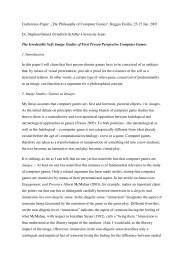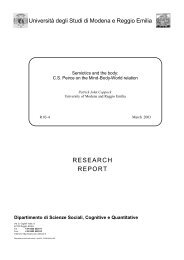Playing Dress-Up: Costumes, roleplay and imagination
Playing Dress-Up: Costumes, roleplay and imagination
Playing Dress-Up: Costumes, roleplay and imagination
You also want an ePaper? Increase the reach of your titles
YUMPU automatically turns print PDFs into web optimized ePapers that Google loves.
<strong>Playing</strong> <strong>Dress</strong>-<strong>Up</strong> Ludica<br />
is not unusual for players to maintain inventories of dozens of distinct avatar personas, as easy to<br />
put on as a new outfit. (As an example, one of this paper’s authors has nearly 2 dozen, including<br />
twins, whom she plays on two computers simultaneously. Another has multiple variants of the<br />
same trans-ludic character, which moves between different games <strong>and</strong> virtual worlds.)<br />
• Mastery <strong>and</strong> Status: Taylor points out the different ways that women represent mastery <strong>and</strong><br />
status; in many of the more structured “ludic” MMOGs, these qualities are indicated in large part<br />
by armor. In EverQuest, for instance, “newbie” players appear scantily clad. As players advance<br />
in the game, they don progressively more clothing, so that the measure of a player’s level of<br />
advancement is often a product not only of the type but also of the amount of clothing they wear.<br />
As mentioned in the discussion of armor/instrumental dress-up mechanics, armor expresses not<br />
only character but also status: the “inspection” mechanic allows players to view the statistical<br />
values of others’ “gear.” In more open-ended worlds such as There.com <strong>and</strong> Second Life,<br />
possessing fashion items is a sign of status (such as leveling in the “Fashionista” category in<br />
There.com) as well as income. In addition, players who design fashions, the vast majority of<br />
whom are female, receive a high level of social <strong>and</strong> economic status in virtual worlds.<br />
Figure 14: A scantily clad “newbie” Level 1 Warrior (right) <strong>and</strong> a<br />
decked out Level 60 Dark Elf in World of Warcraft. (Images: Pearce)<br />
• Exploration: We are currently working on another paper that addresses exploration in terms of<br />
games <strong>and</strong> gender, but it also relevant to dress-up in some game contexts. As mentioned earlier,<br />
some dress-up is site- <strong>and</strong> context-specific. In Second Life, where one must travel (virtually) to<br />
shops in order to purchase items, display of clothing is a creative activity in <strong>and</strong> of itself. Owning<br />
real estate also permits one to erect stores <strong>and</strong> display merch<strong>and</strong>ise for sale, often widely<br />
distributed across the entire world space, so “shopping” actually requires exploratory activity.<br />
This differs from There.com’s in-game auction system, mentioned earlier. And in the more ludic<br />
contexts of EverQuest <strong>and</strong> World of Warcraft, because “gear” is often the result of quest “drops”<br />
(spoils of war, as it were) highly coveted items can often be associated with having been to a<br />
certain place. In both Second Life <strong>and</strong> There.com, the variety of role-playing <strong>and</strong> other<br />
opportunities create context-specific dress-up scenarios, some of which might even be tied to the<br />
exploration mechanic. For instance, players in There.com who are part of an aviator club will<br />
often don special uniforms to perform air acrobatics. In Second Life, the ease of changing avatars<br />
Philosophy of Computer Games 2007 Page 16






